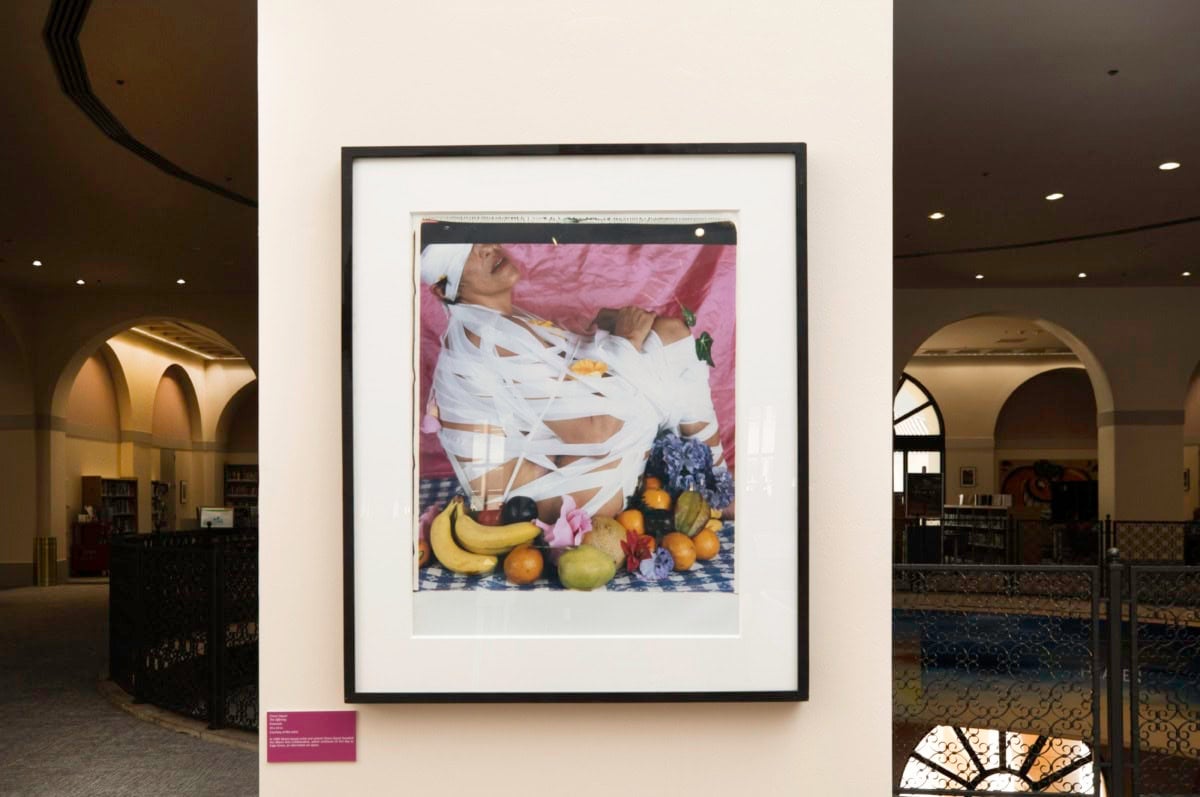
Women’s Voices: A Journey Through Miami’s Art History, currently on view at the Miami-Dade Public Library, is an exhibit that safeguards local histories. The show illustrates a multiplicity of stories from women and non-binary artists dating back to the 1970s who made significant contributions to Miami’s cultural landscape and American contemporary art. This show is for those who care about memory.
Curator and Miami-based archivist Anita Sharma addresses the concept of “community archives,” which, unlike institutional archives, are created by community groups interested in documenting their cultural heritage based on identities or shared experiences. “If we write our art history in truly reflective ways, the result is an inclusive, equitable, and intersectional account,” stated Sharma. “It’s time we challenge the parameters that definite the traditional art historical canon.” Women Artists Archive Miami (WAAM) was created in response to the growing need for an archival presence for female-identifying and non-binary artists in the city. The exhibit generates responses to pertinent questions: How can one counter the erasure of women and non-binary artists’ narratives in local art histories? How can one preserve and highlight the varied stories of artists working in communities and neighborhoods across the city?
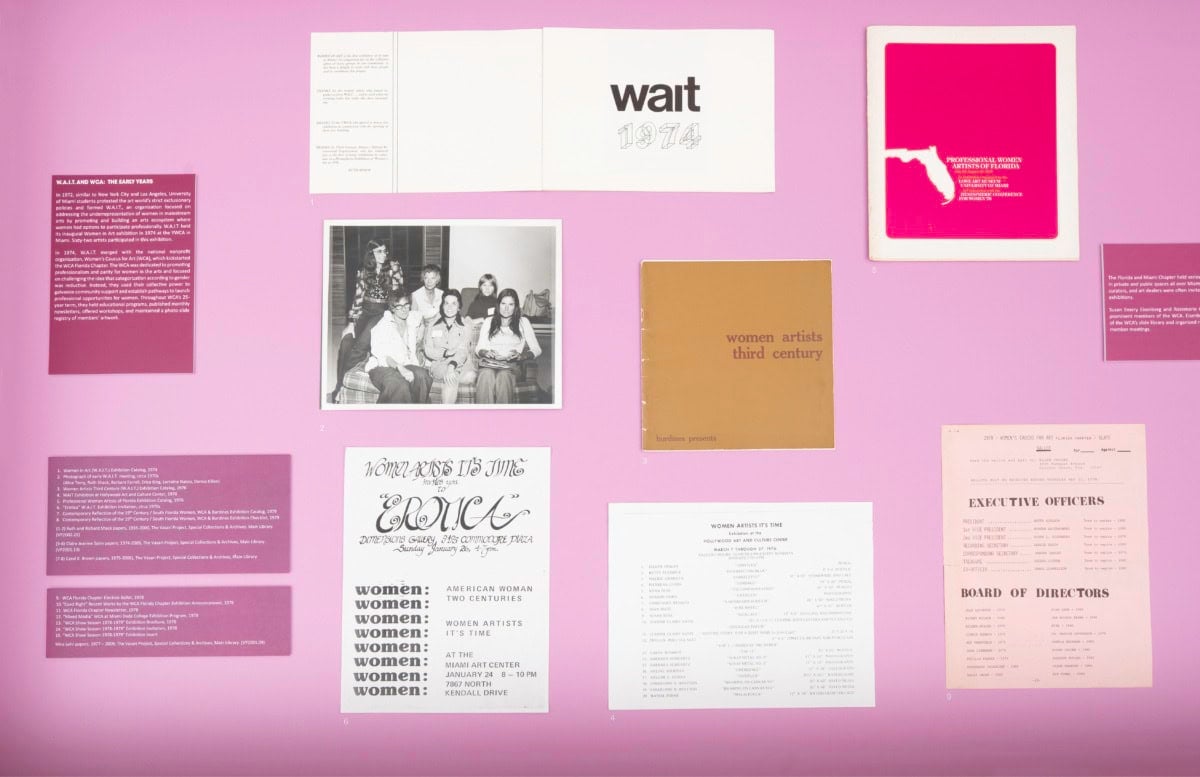
The exhibit opened during Art Week in December, when tourists and outsiders flock to the art fairs and galleries looking at art usually made by people not from Miami. But this show, and this particular space, contains decades of Miami’s less-told history. In the sun-lit library in Downtown Miami, the walls covered with framed art from locals, holds approximately 7,000 works in its permanent art collection, focusing on Miami-based Latin, Black, and Caribbean artists. It is also the home of The Vasari Project, a live, ongoing archive documenting Miami’s art history with approximately 6,000 items dating back to 1945. It was founded in 2000 by historian Helen L. Kohen and the Library’s then-head of Art Services and Art Librarian Barbara N. Young and currently host’s WAAM’s exhibit.
This exhibition on the library’s second floor features the Miami women’s art movement’s beginnings during the civil rights movement and archives materials from that date until the 2000s. Catalogs, exhibition posters, documentation, letters, ephemera, photographs, and artworks belonging to artists such as Kabuya Pamela Bowens-Saffo, Claire Jeanine Satin, Karen Rifas, Lynne Golob Gelfman, Rosemarie Chiarlone, and Charo Oquet are on display. Many of these artists continue to live and work in the city.
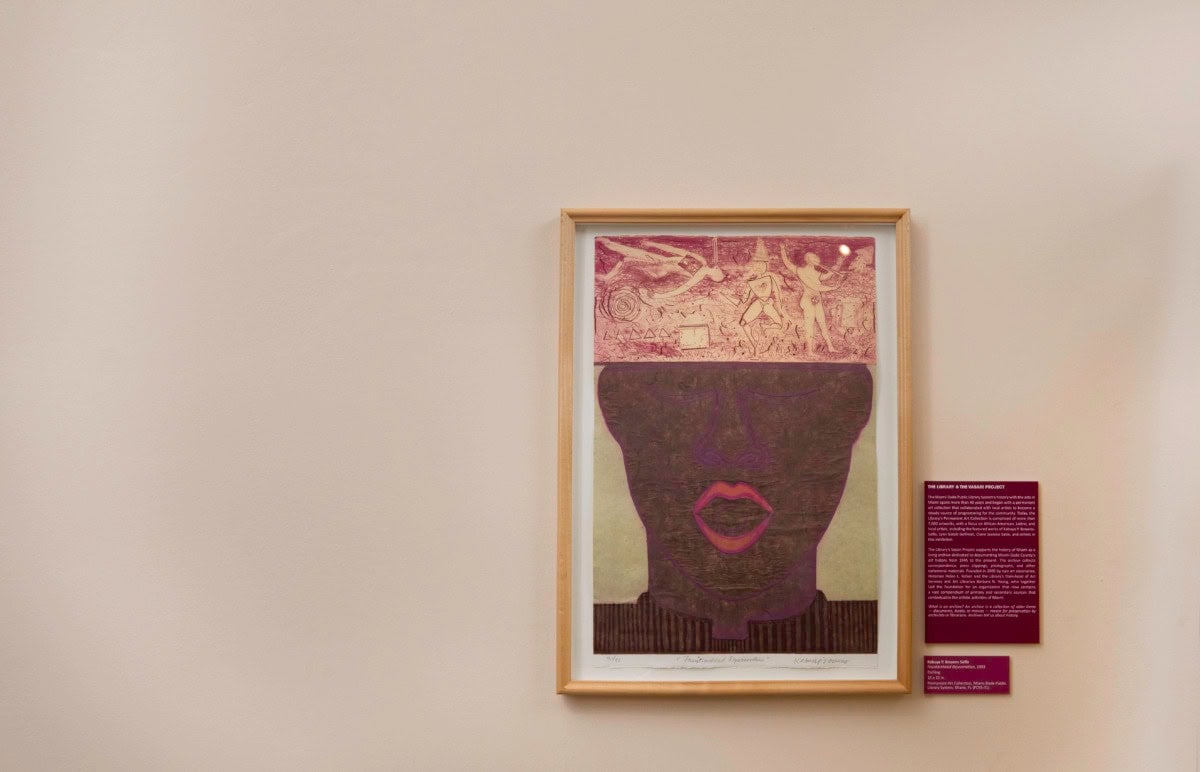
Included in the exhibition is ” teaching philosophy” statement by Dr. Paula Harper, a leading women’s art movement figure who created the Feminist Art Program at the California Institute of Arts (CalArts) in 1971 with artists Judy Chicago and Miriam Schapiro. From 1983 to 2011, she was a Modern Art History and Criticism professor at the University of Miami. During this time, she wrote extensively for the Miami News and regularly contributed to the “Art in Miami” column. Also included are photographs and archives from groups such as Women Artists Its Time (W.A.I.T.), founded by University of Miami Students in 1972 to address the exclusion of women in the art world; The Miami Black Arts Workshop (1969) created for Black artists to counteract exclusion; and the Women’s Caucus for Art, Florida Chapter (1974) and Miami Chapter. Many artists featured in this exhibit were active members of these groups.
Along with that memorabilia, Women’s Voices features the work of contemporary women artists who created, or continue to create, new narratives and genealogies that reflect the multiplicity of their experiences. One work is an etching by Bowens-Saffo, Fountainhead Rejuvenation (1993), with the face of a woman holding her mouth open in a sigh or a scream, her brown skin textured with print strokes. On top of the painting is a drawing about human creation, which looks like the beginning of an epic poem. Specializing in printmaking and mixed-media constructions, Bowens-Saffo grew up in Miami and attended Howard University. There, she was inspired by the AfriCOBRA movement, an African American artists’ collective. Her work engages African-American history, including references to legendary figures, and explores everyday socio-political human relations. Bowens-Saffo was a member of Miami Black Arts Workshop. She continues to work in Florida and is the chief curator at the Anderson Brickler Gallery in Tallahassee, a space that focuses on artists from the African Diaspora. The gallery also intends to connect the work of artists with community outside of the arts. In 2020, for example, during the COVID-19 pandemic, she created and distributed art posters in gratitude to essential workers of color.
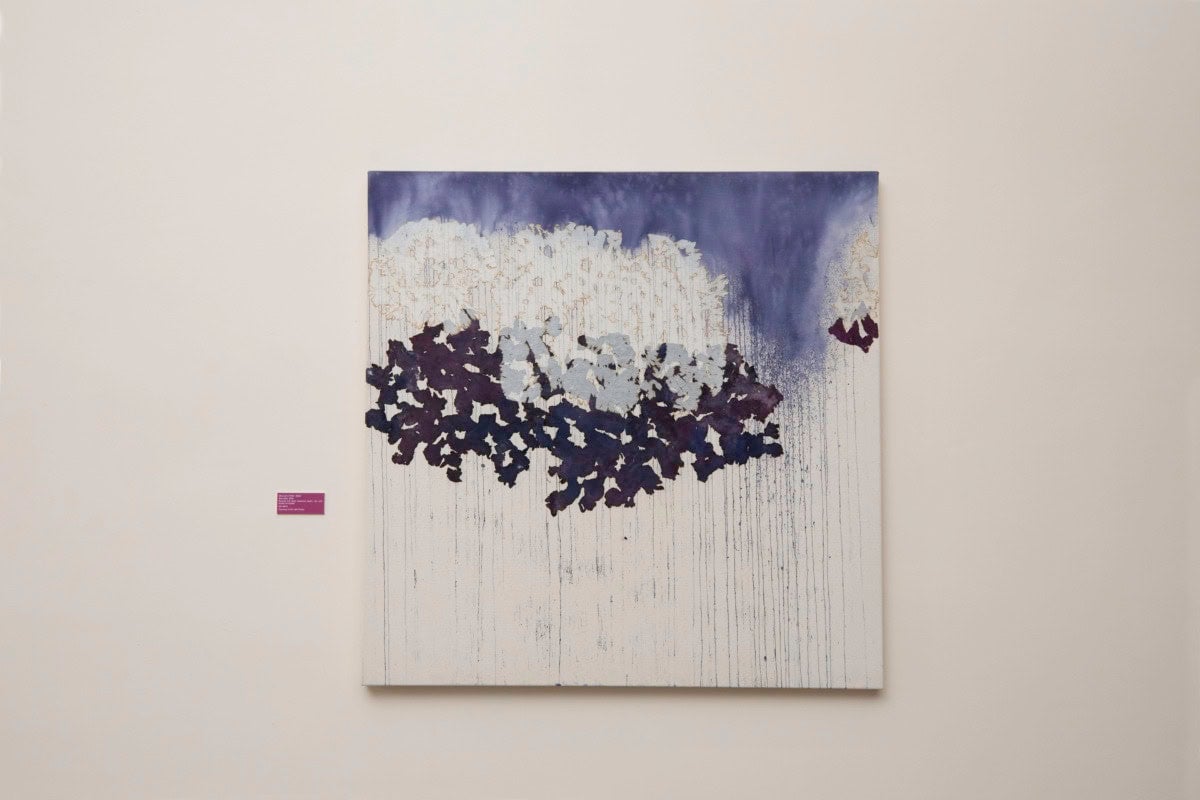
Included in the exhibition is a painting by Mira Lehr (1934-2023), titled Blue Mist (2020), which uses burnt and dyed Japanese paper, ink, and acrylic on canvas. The work addresses Miami’s natural world and climate issues. The ink on Japanese rice paper invokes cotton flower imagery, draped by translucent brush drops that look like rain on a canvas. Through her life, Lehr worked in varied forms in her work from depicting endangered corals, installing a mangrove labyrinth, and using gunpowder to mark surfaces. The artist shows the other side of creation. In the 1960s, she co-founded Continuum Gallery in Miami Beach, one of the country’s first co-ops for women artists.
Included in this survey is Dominican-born, Miami-based artist and activist Charo Oquet. Her creative force highlights the city’s Caribbean connection. A lush polaroid documents a performative piece from her 2004 series, The Offering. Oquet is presented as the offering itself, naked and wrapped in white tissue paper at the center of a colorful fruit banquet. In the image, Oquet’s brown skin contrasts with the white of the wrapping, her eyes covered, and her hands tied. In 1996, she founded the Miami Arts Collaborative, which continues to this day as Edge Zones Gallery, an artist-run experimental art space in Wynwood. Oquet incorporates cultural and spiritual practices from Afro-Caribbean folk and religion; her sculptures, installations, and photography reflect her unique and vibrant version of spirituality and ritual.
Susan Emery Eisenberg was an active member of the W.C.A. and “contributed to archiving this burgeoning movement,” according to Sharma. An acrylic painting, Dark Rage (#11 in Rage Series) (1998), portrays a face staring at the viewer with hollow and deep, dark eyes. The paint strokes are energetic, almost violent, over the face, and the mouth is closed and silent, hinting that it’s through the eyes where this rage is coming.
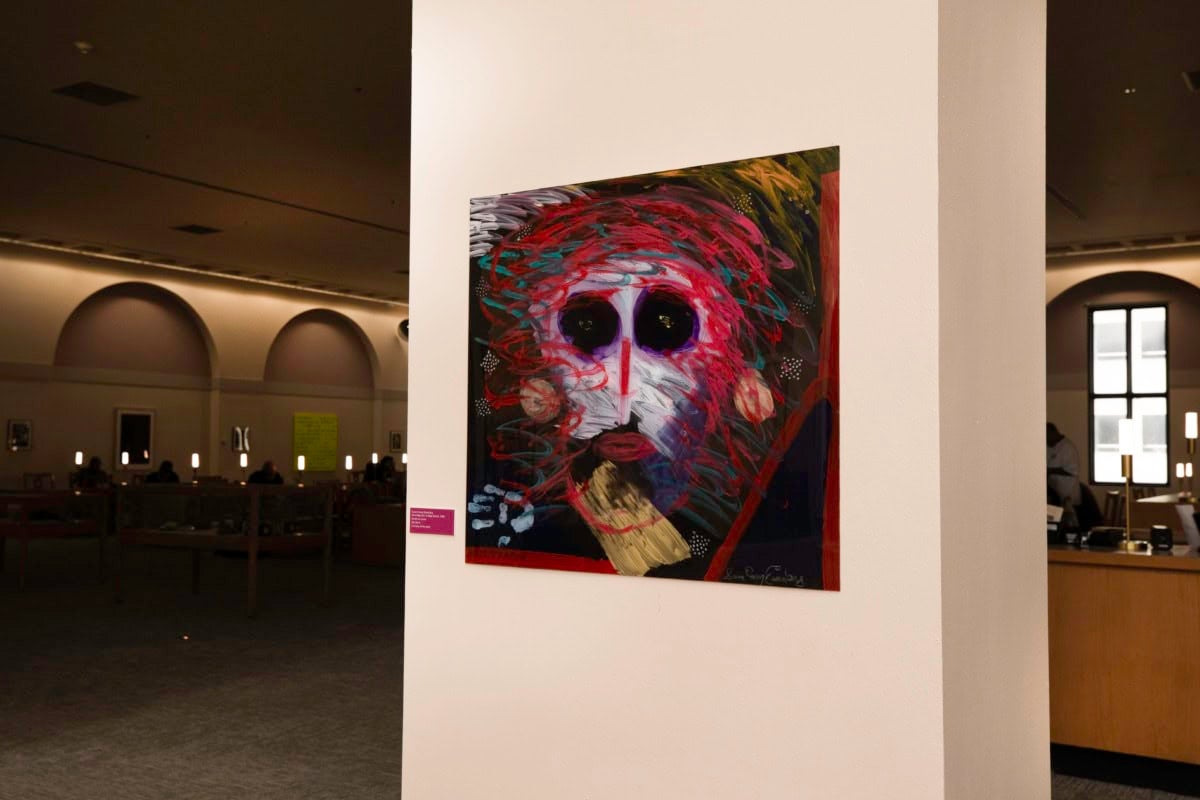
In a city that is growing too fast, displacing local artists and communities, there is an even more pressing need to highlight the works of those who are present and still here. “Furthermore, a new generation of artists, including Johanne Rahaman, Chire Regans, Sophia Lacroix, Susan Lee-Chun, Zonia Zena, and many more, is actively reshaping established paradigms. Another exhibit at the Miami Beach Public Library Branch, Women’s Voices: New Perspectives in the Archives, features work from these contemporary voices. Their work challenges dominant narratives, prioritizing themes of social justice, inclusion, and community engagement,” said Sharma. Their archives and legacies are a part of Miami’s art history as well.
This show is for those who care about memory.
Submerged in the silence of the Library building, the voices of some of the artists who opened doors for the new generations are latent in this show. The work they did yesterday can influence the future, but for this to happen, it is essential to do the memory work. Artist Dinizulu Gene Tinnie spoke to younger generations about the history and legacy of the Miami Black Arts Workshop in a 2021 talk at the Frost Museum of Art, “We preserve history for future generations, but this is as much, if not more, about the future as it is about the past. There is a time now for a revival of that kind of collective energy in service of a larger cause.” May the community archives hold a key to this potential future, as much as they safeguard the local histories of the past.




